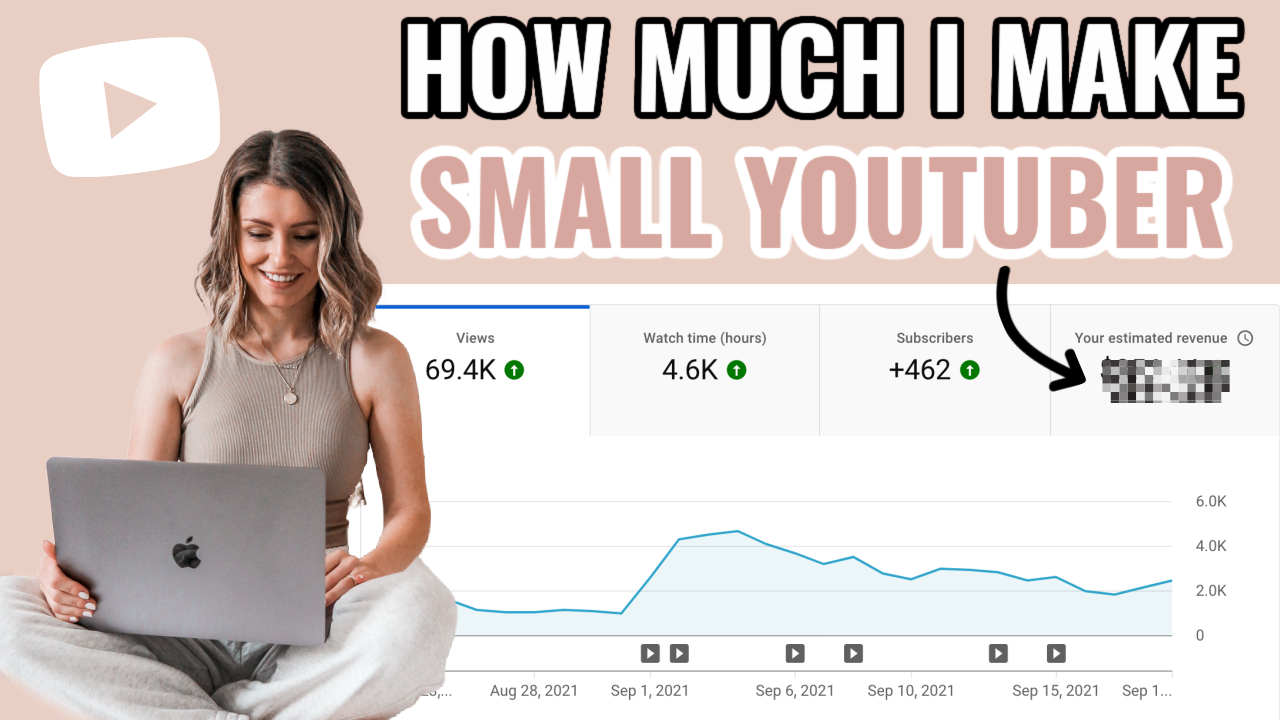When we think about YouTube, it's hard not to wonder just how much creators earn on a platform that has changed the way we consume media. With 700,000 subscribers, many people are curious about the potential earnings of these YouTubers. It's an intriguing topic, filled with varying figures and methods of generating income. In this post, we’ll dive into the world of YouTube earnings and break down the different revenue streams available to content creators. So, if you've ever been curious about how much a channel of this size can bring in, you're in the right place!
Understanding YouTube Revenue Streams

YouTube has transformed into a significant source of income for many content creators, and understanding the various revenue streams can give insight into how much they really earn. Here are the primary ways that YouTubers generate income:
- Ad Revenue: The most commonly recognized income stream is through Google's AdSense program. YouTubers earn money based on the number of views and clicks on ads displayed on their videos. Typically, channels earn between $1 to $3 per 1,000 views.
- Sponsorships: As channels gain popularity, brands may pay YouTubers to promote their products or services. This can range anywhere from a few hundred to tens of thousands of dollars per sponsored video, depending on the creator's niche and engagement rate.
- Merchandise Sales: Many YouTubers capitalize on their brand by selling merchandise such as T-shirts, mugs, or other products. This not only generates additional revenue but also helps strengthen their relationship with fans.
- Memberships and Donations: Platforms like Patreon or YouTube's Membership feature allow fans to support creators directly. This can provide a steady income stream if a dedicated fanbase is in place.
- Affiliate Marketing: This involves promoting products and including links that lead to a commission for any sales made through those links. Creators can potentially earn a significant amount depending on their audience’s buying behavior.
While the numbers may vary, understanding these avenues helps shed light on how YouTubers can truly capitalize on their subscriber base. The key takeaway is that earnings aren’t purely reliant on the number of subscribers, but rather on engagement, audience interest, and the creator's ability to leverage multiple revenue streams.
Ad Revenue: The Primary Source of Income
When people think about YouTube earnings, the first thing that often comes to mind is ad revenue. This is indeed one of the biggest contributors to a YouTuber's income, and for those with 700K subscribers, it can be quite significant!
So, how does it work? YouTube operates a program called AdSense, which places ads on your videos. Creators earn money based on a combination of:
- CPM (Cost Per Thousand Impressions): This is how much advertisers are willing to pay for a thousand views of their ads. CPM rates can vary widely based on factors like audience demographics, seasonality, and genre of content.
- Engagement: Videos that keep viewers' attention usually attract higher ad rates. If your audience tends to stick around and watch your content in its entirety, this can boost your earnings.
- Geographic Location: Advertisers often pay more for views in certain countries like the United States or Canada compared to other regions.
On average, a YouTuber may earn anywhere from $0.25 to $4 per 1,000 views. For someone with 700K subscribers, let’s assume an average view rate of 10%. If each video garners about 70,000 views, the calculation would look something like this:
| Ad Revenue Rate | Estimated Earnings per Video |
|---|---|
| $1.00 CPM | $70 |
| $2.00 CPM | $140 |
| $3.00 CPM | $210 |
This means that a YouTuber with 700K subscribers could potentially earn between $70 and $210 per video from ads alone. While it varies greatly, ad revenue remains a fundamental pillar of YouTube income!
Sponsorships and Brand Deals
Now, let’s dive into another exciting revenue stream for YouTubers: sponsorships and brand deals. Once you hit the 700K subscriber milestone, brands start to notice you, and that's when the offers begin to roll in!
So, what do these partnerships look like? Usually, a brand will reach out to you to promote their product or service in exchange for cash or free products. Here are some common structures of these deals:
- Product Placement: This is when a YouTuber features a brand’s product within their content. For example, showcasing a new gadget during a tech review.
- Dedicated Videos: Some brands pay for a whole video dedicated to their product. This could be a tutorial, unboxing, or review.
- Affiliate Marketing: Brands might provide a unique link for you to share. When followers purchase through that link, you earn a commission.
The amounts can vary enormously based on several factors:
- The size of your audience: Larger channels command higher fees.
- The niche: Some niches, like technology and finance, tend to have higher sponsorship payouts than others.
- Your engagement rates: A highly engaged audience can make you more appealing to brands.
For a YouTuber with 700K subscribers, sponsorship fees can range from $1,000 to $15,000 or more per video, depending on all those factors! It’s an exciting opportunity that allows creators to diversify their income and stay connected with their audience by promoting products they love.
5. Merchandising Opportunities
When a YouTuber reaches the milestone of 700,000 subscribers, they open up a whole new world of merchandising opportunities. This is not just about selling random items; it’s about building a brand that resonates with their audience. Here are some key areas where YouTubers can tap into merchandising:
- Branded Merchandise: This includes t-shirts, hoodies, and hats featuring catchphrases, logos, or artwork that fans love. Many successful YouTubers create merchandise that reflects their unique style or content theme.
- Collaborations: Partnering with designers or other brands can help create exclusive items that garner more attention. Collaborations can be a great way to expand their audience and bring fresh designs to the table.
- Custom Products: Items like phone cases, mugs, or even stickers that are tailored to the YouTube community can lead to significant sales. Fans often enjoy having something tangible to show their support.
- Limited Editions: Creating limited edition merchandise can spark urgency among fans. People love getting their hands on exclusive items that not everyone can have.
Understanding their audience is crucial for YouTubers. The goal is to create products that not only showcase their brand but also resonate with followers on a personal level. When done right, merchandising can be a lucrative revenue stream.
6. Memberships and Crowdfunding Platforms
With 700,000 subscribers, a YouTuber can leverage memberships and crowdfunding platforms to further monetize their content. These avenues can provide a steady income while fostering a deeper connection with their fanbase. Here’s how these options work:
- YouTube Memberships: This feature allows subscribers to pay a monthly fee for exclusive perks like badges, emojis, and members-only content. It's a win-win as loyal fans get extra content, and YouTubers enjoy additional revenue.
- Patreon: Many content creators turn to Patreon, where fans can support their favorite creators for a monthly fee. In return, patrons can receive behind-the-scenes content, early access to videos, and even one-on-one interactions.
- Crowdfunding Campaigns: Platforms like Kickstarter or Indiegogo allow YouTubers to launch campaigns for specific projects—a new video series, a documentary, or even a podcast. Fans can contribute towards a goal and receive rewards based on their pledge levels.
- Exclusive Content: Offering behind-the-scenes looks, tutorial videos, or live Q&A sessions through memberships or crowdfunding can create a sense of exclusivity, making followers feel special and appreciated.
Memberships and crowdfunding not only create an additional income stream but also enhance community engagement. When subscribers feel involved and invested in a YouTuber's journey, it strengthens the bond between influencer and fan.
Factors Influencing Earnings
When it comes to estimating how much YouTubers earn with 700K subscribers, several factors come into play. Let's break these down, so you can get a clearer picture of what influences earnings on the platform.
- Ad Revenue: This is perhaps the most straightforward source of income. YouTubers earn money through ads displayed on their videos. The rate is usually measured in CPM (cost per thousand views), which can fluctuate widely based on factors such as audience demographics, engagement rates, and the type of content.
- Sponsorships: Many YouTubers partner with brands for sponsored content. If a channel has 700K subscribers and a loyal following, brands may pay a substantial amount for promotion. Sponsored video fees can range from a few hundred to several thousand dollars, depending on the influencer's niche and audience engagement.
- Merchandise Sales: Some YouTubers expand their brand by selling merchandise. Products like apparel, accessories, or custom items can significantly boost earnings, especially if the influencer has a core customer base that engages with their brand.
- Memberships and Donations: Platforms like Patreon allow fans to support their favorite YouTubers through memberships and donations. YouTubers can offer exclusive content for paying subscribers, which can generate a steady stream of income.
- Audience Engagement: The level of engagement (likes, comments, shares) on a channel plays a crucial role in earnings. Higher engagement can lead to better ad rates and more lucrative sponsorship deals.
In conclusion, while having 700K subscribers is a significant milestone, the actual earnings from YouTube can vary greatly depending on these factors.
Conclusion
So, how much do YouTubers with 700K subscribers actually earn? The answer isn't straightforward. Depending on various factors, a content creator at this level could earn anywhere from a few thousand to well over $10,000 a month. It's quite a wide range, isn't it?
Here's a quick recap of what we covered:
- The average CPM can range between $0.25 to $4 (or more) depending on the niche.
- Sponsorships can significantly increase earnings, sometimes surpassing ad revenue.
- Engagement levels can open up additional revenue streams, like memberships and merchandise sales.
Ultimately, success on YouTube is not solely defined by subscriber count. It's about creating quality content that resonates with your audience, understanding your niche, and leveraging various income streams to maximize earnings. So whether you're a budding creator or just curious about how the platform works, there's a lot to explore in the vibrant world of YouTube!
 admin
admin








